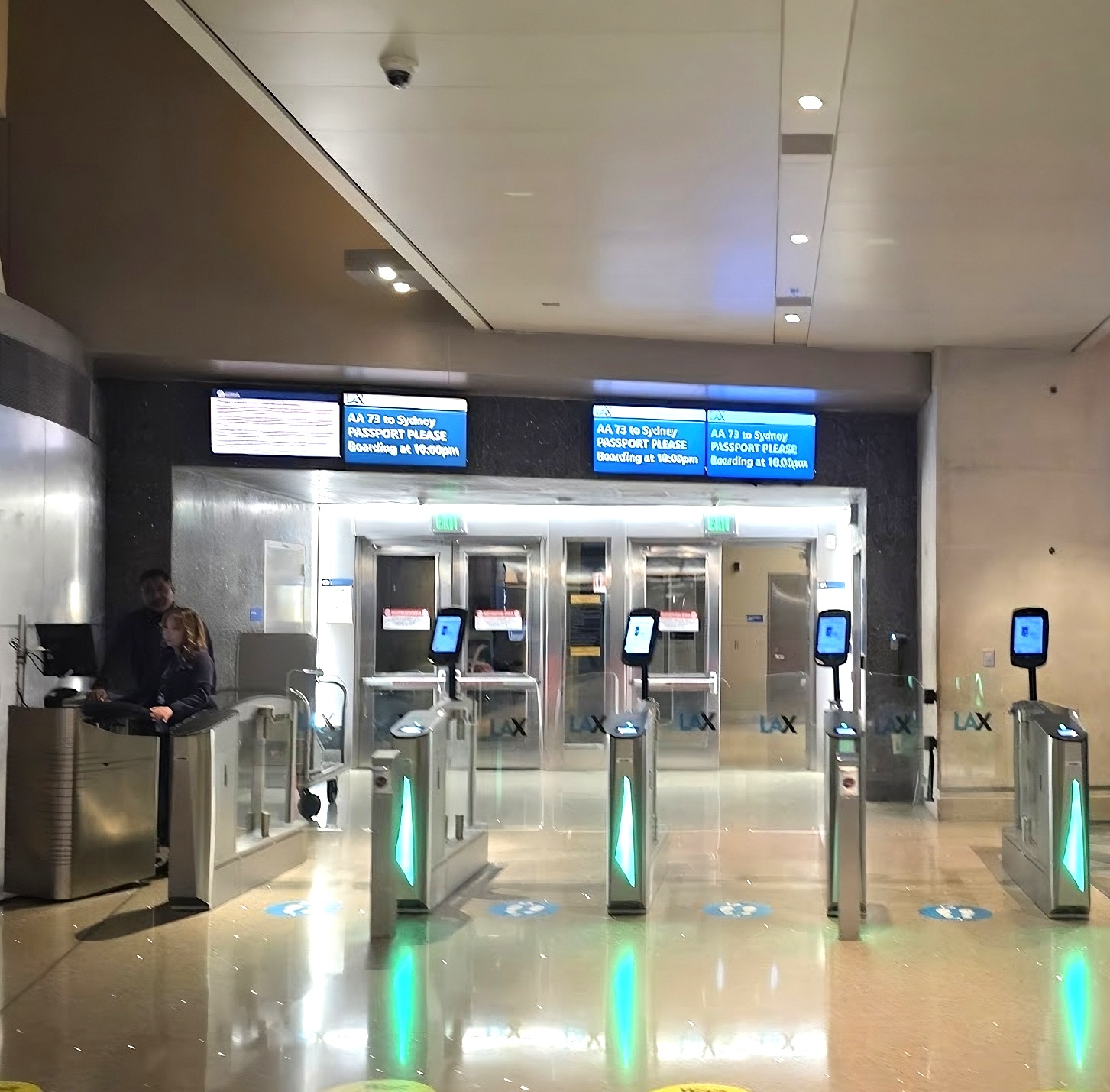At many international departure gates, a camera is mounted at the gate or held by a government customs officer or airline staff member, to take a live photo of each passenger during boarding.
That image is sent to the Customs and Border Protection cloud-based Traveler Verification Service, which compares each person’s mugshot to a gallery built from your passport or visa photo and compares it to the flight manifest. The government has already checked the flight manifest and decided who can travel and who can’t. Now they want to match people against the manifest. If there’s a match, you’re allowed to depart the country. If there’s no match, you get a manual document check.
Historically, the U.S. didn’t have exit controls. The government vetted people entering the country, but there was no checkpoint to leave. Now we have “biometric exit.”
And this is expanding. An ‘interim final rule’ cleared this month, removing limits in place for the program’s pilot and authorizing nationwide deployment across air, sea and land borders.

Biometric Gates at LAX
The program has been nearly a quarter century in coming. It’s authorized by 8 U.S.C. § 1365b which originated with 2001’s PATRIOT Act and was further developed in the Enhanced Border Security Act of 2002.
In theory, U.S. citizens can opt out and get a manual ID boarding pass check instead. But there’s still an exit checkpoint to compare people against the manifest in order to verify that you’re authorized to leave. Customs and Border Protection says live photos are retained for up to 12 hours and then deleted.
- Actual experience is that opt-out notices at gates can be hard to find
- And that government and airline staff inconvenience passengers who opt out
The imigration agency’s traveler verification service is also used at TSA checkpoints, and has already become effectively less optional as its use becomes more widespread.
I used to think of the U.S., U.K., and Canada as being pretty unique in not having departure immigration controls. You just leave the country, but that really isn’t true anymore.
- United States: while there’s no departing immigration step to go through along with security, airlines are required to transmit departure manifests for every international outbound flight. The government has the opportunity to bar exit. And there’s now ‘biometric exit’ (facial recognition at the boarding gate) at 57 airports.
- United Kingdom: while there’s no staffed outbound immigration counters, the U.K. runs ‘exit checks’ where airlines scan passports and transmit data to the Home Office on all scheduled international departures. It’s not a physical exit booth, but exit controls have been in place since 2015.
- Canada: has no staffed outbound booth at airports, but they began collecting land exit data in 2019, and air exit data in mid-2020 from airline manifests.
And while most countries have immigration checkpoints to pass through prior to departure, it’s still the case that you can leave Ireland without one (as with others, they receive passenger reservations data and can effectively stop exits when desired) and the same goes for the Bahamas when leaving for countries other than the U.S. where passengers go through U.S. immigration (preclearance) prior to departure.
If you’re flying an international departure from the U.S., assume going forward that there may be a face scan at the gate.
These scans fail to match around 3% of the time – much higher for darker-skinned people and women – which means delaying their boarding. These tools are expected to extend to “every transaction in the airport” and airline participation gets them access to the data, which then becomes commercialized.

The Latin phrase civis romanus sum or “I am a Roman citizen” was enough to travel across the vast Roman Empire unaccosted, because the retribution of Rome was known to be both fierce and certain if one of their citizens was harmed. That was the Roman passport.
Modern passports weren’t needed to travel much of the world before World War I.
We’ve come a long way in the wrong direction over the last 100 years. You now have to ask permission from the government to leave, not just enter. But that’s been true for years – it just wasn’t as obvious, your biometrics weren’t collected for it, and that’s something that’s only expanding.
I’m an old fashioned civil libertarian, which makes me something of a dinosaur. I realize the ship on this has sailed, but I’ll still mourn the passing of a time when we didn’t need to show our papers – back when those papers weren’t digitized.


I feel the same way, Gary. And the digitizing system worked very poorly for me when I spent two months in the Dominican Republic. My beard got thicker and the computer couldn’t match the picture of me coming in with that going out. Eventually someone just overrode it.
But you know, given this administration’s obsession with getting people who they don’t want in the U.S. to leave, you would think that they would go the other way. Happily wave everybody out the door, the more the better, while making it tougher to return.
Biometric boarding is still OPTIONAL on international departures. This was purely a convenience for airlines to not staff gate agents for self boarding.
Similar to TSA you can still opt out and the amount of people doing so is increasing. Ironically, cuz DJT and California is quite pushing back on this. Ironically, last year they were all for it and wanted to use biometrics to verify vaccine cards etc…..so there was no fake vaccine passports out there…..
Privacy is privacy no matter what the issue…..
@ Gary — “Sent to the cloud.” What could possibly go wrong?
As always, well said, @drrichard.
Gary, you’d think those of us who frequent your blog would be in-favor of the relatively free and orderly movement of people and commerce, globally; you know, because we travel a lot… instead, we unfortunately have a small cohort of incredibly restrictive, regressive, and revisionist folks, who inevitably are gonna spread some horrible thoughts about this policy and their fellow humans. *deep sigh*
CBP may retain your live photos for up to 12 hours, although I highly doubt it, but the DHS, FBI, NSA, etc. will keep them long after you’re dead.
Ironically you can now leave many former Warsaw Pact countries into Western Europe without a passport or any papers. My how times have changed.
This is so easily extrapolated to nightmare scenarios. Pics get taken of peaceful protesters. Those get kept indefinitely by the FBI. Pics can be shared between government databases. Protesters get labeled part of “a terrorist organization.” Someone who protested peacefully could then be headed out of the country for a [much needed] vacation. Their pic flags them in the database as a “known terrorist.” Not only are they refused boarding/leaving — they get imprisoned without a warrant or probable cause. It could also be used to keep women from leaving (because @bortions!) and imprison them too. And once birthright citizenship is revoked, they’ll use this as a way to abuse people, because the cruelty is the point, not having more people leave voluntarily.
@LS – we can only hope this info is used for these purposes. I’m all for cracking down on protestors specifically. Most are radical and if not terrorists they do often break laws and commit terroristic acts. They need to start paying for their actions and I’m glad we are now committed to cracking down on them. About time the US and law enforcement grew a set of
in other news, ICAO decided to deny IATA’s request to raise mandatory pilot ages from 65 to 67 which makes it very unlikely to succeed in the US.
Bring out your tin foil hats!
@Retired Gambler — You’re referring to January 6, right? Oh, you’re not…see.
I’m a little lost on the issue. The state, or almost all of us, have had our photos from our Drivers License.
Now the feds have it directly rather than getting them from the state.
In the meanwhile, TSA lines are much quicker.
Unless you are arguing for no photo ids ever, including for drinking age and drivers license.